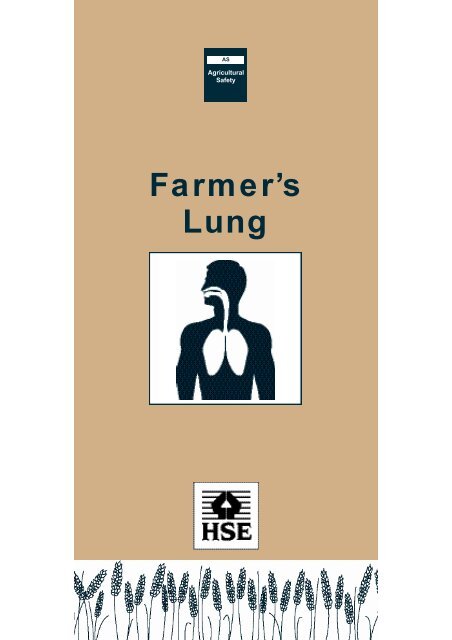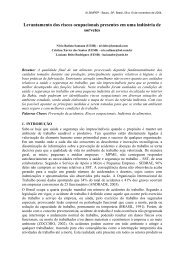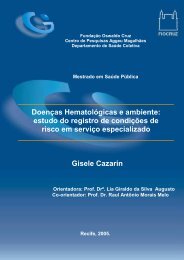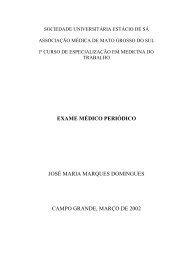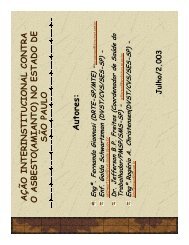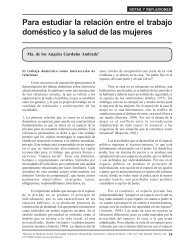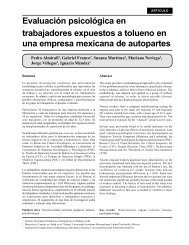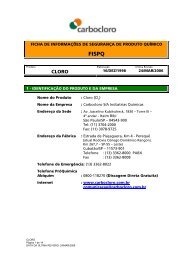as5 - Farmer's lung - HO - Higiene Ocupacional
as5 - Farmer's lung - HO - Higiene Ocupacional
as5 - Farmer's lung - HO - Higiene Ocupacional
You also want an ePaper? Increase the reach of your titles
YUMPU automatically turns print PDFs into web optimized ePapers that Google loves.
AS<br />
Agricultural<br />
Safety<br />
Farmer’s<br />
Lung
Dust can cause serious illness. Are you at risk?<br />
Which dusts are dangerous?<br />
Hay, straw, grain and similar farm produce can<br />
go mouldy and produce the spores of the microorganisms<br />
that cause farmer’s <strong>lung</strong>.<br />
Handling the compost used in mushroom<br />
growing also gives rise to the micro-organisms<br />
that cause a similar disease called mushroom<br />
worker’s <strong>lung</strong>. Mushroom spores themselves<br />
very rarely cause this disease.<br />
Dry dust from grain and feedstuffs can cause<br />
irritation or asthma, eg harvest worker’s <strong>lung</strong>.<br />
Poultry feathers and droppings can cause<br />
allergies - poultry breeder’s <strong>lung</strong>.<br />
Dust in intensive livestock houses can also<br />
cause similar respiratory ailments.<br />
How does dust get into the body?<br />
Larger dust particles are stopped in the nose<br />
and breathing passages where they can cause<br />
irritation or bronchitis. Smaller ones, including<br />
the mould spores that cause farmer’s <strong>lung</strong> and<br />
mushroom worker’s <strong>lung</strong>, are carried right into<br />
the <strong>lung</strong>s.<br />
What effects does it have?<br />
Short term effects include:<br />
●<br />
●<br />
irritation of the nose and eyes;<br />
acute bronchitis with cough and phlegm;
●<br />
●<br />
●<br />
acute farmer’s <strong>lung</strong> with fever, headache,<br />
chest tightness, breathlessness and weight<br />
loss;<br />
acute occupational asthma with chest<br />
tightness and wheezing;<br />
grain fever with shivering, headache, fever<br />
and general aches and pains.<br />
Longer term effects include:<br />
●<br />
●<br />
●<br />
●<br />
chronic bronchitis with cough, phlegm and<br />
shortness of breath;<br />
chronic farmer’s <strong>lung</strong> with increasing shortness<br />
of breath and weight loss;<br />
chronic occupational asthma with persistent<br />
chest tightness and wheezing;<br />
damage to the heart.<br />
What should you do to protect yourself?<br />
If you:<br />
●<br />
●<br />
●<br />
●<br />
handle hay, straw, grain or similar produce<br />
that has been harvested in damp conditions<br />
and stored in a way that leads to heating<br />
and drying out;<br />
work with mushroom compost;<br />
are exposed to dry dust from the harvesting<br />
and storage of grain or the milling, moving<br />
and handling of feedstuffs;<br />
work with intensively kept livestock, eg pigs<br />
and poultry;<br />
you should, wherever possible, avoid breathing<br />
in dust and spores by taking the following<br />
precautions:
●<br />
●<br />
●<br />
●<br />
●<br />
●<br />
●<br />
do not create more dust than necessary<br />
when working;<br />
ensure that machinery is constructed,<br />
adapted and maintained so as to contain<br />
dust as far as possible;<br />
where materials are handled indoors, make<br />
sure there is adequate ventilation - either<br />
local exhaust ventilation or dilution<br />
ventilation of the whole area. Get a<br />
competent person (eg a ventilation<br />
engineer) to confirm that it is adequate;<br />
observe good housekeeping where<br />
materials are being handled. Use an<br />
industrial vacuum cleaner to remove<br />
excess dust from the floors, walls and<br />
rafters of buildings. If you have to use a<br />
brush, thoroughly wet the dust beforehand<br />
to stop it from rising;<br />
keep personal clothing and hair clean, eg<br />
by wearing a coverall and headgear;<br />
use disposable protective clothing,<br />
otherwise ensure your working clothes are<br />
laundered regularly. Do not take them<br />
home with you - leave them at the<br />
workplace;<br />
where other methods of preventing<br />
exposure are not reasonably practicable,<br />
wear suitable, properly fitted and maintained<br />
respiratory protective equipment (RPE).<br />
What the law says<br />
All employers, self-employed and employees<br />
have certain duties and responsibilities under<br />
the Health and Safety at Work etc Act 1974.
Under the Control of Substances Hazardous to<br />
Health Regulations 2002 (COSHH), employers<br />
and the self-employed are required to make an<br />
assessment of the risk to health from the work<br />
activity, to introduce and maintain control<br />
measures and to inform, instruct and train<br />
employees about the risk and precautions to be<br />
taken.<br />
If you employ people who are regularly exposed<br />
to dust, COSHH would normally require that you<br />
ask if they have any symptoms of respiratory<br />
illness and that you make sure you know the<br />
reason for any absence from work. If employees<br />
suffer from respiratory illness you will need to<br />
prevent further exposure by changing work<br />
methods or otherwise improving control<br />
measures.<br />
The need for health checks<br />
If you have a chest illness and have been<br />
working with dusty material, tell your doctor<br />
about the job you do. You may need to take a<br />
test, such as a blood test, chest x-ray or <strong>lung</strong><br />
function test. If you have access to an<br />
occupational health service you may be able to<br />
have regular health checks.<br />
If you have had an attack of farmer’s <strong>lung</strong>,<br />
mushroom worker’s <strong>lung</strong> or occupational<br />
asthma do not breathe in the dust again - avoid<br />
it or protect yourself. Repeated exposure can<br />
lead to chronic disabling illness.<br />
Selecting and using RPE<br />
Remember the following points when selecting<br />
equipment:
●<br />
●<br />
●<br />
●<br />
●<br />
RPE should only be used as an additional<br />
measure when all other reasonably<br />
practicable means of controlling exposure<br />
to dust have proved inadequate.<br />
RPE can never provide 100% protection<br />
against exposure - there will always be<br />
some leakage of dusty air into it.<br />
RPE must be capable of giving adequate<br />
protection; must be suitable for the purpose<br />
and CE-marked with the appropriate<br />
standard of manufacture.<br />
Suitable RPE includes a disposable filtering<br />
face piece respirator to BS EN 149 or a half<br />
mask respirator to BS EN 140 with particle<br />
filters to BS EN 143. The performance of<br />
both types of respirator depends on a good<br />
face seal. Include fit testing in the selection<br />
process.<br />
Powered respirators such as ventilated<br />
visors or ventilated helmet respirators (to<br />
BS EN 146) may provide similar protection<br />
to approved respirators - if in doubt as to<br />
which type of respirator you need, ask<br />
your supplier.<br />
Before use:<br />
●<br />
●<br />
●<br />
you must have received proper training in<br />
the use of a respirator, including fitting and<br />
maintenance;<br />
examine the equipment for obvious defects<br />
such as worn straps or holes or tears in a<br />
mask;<br />
store equipment ready for use properly<br />
where it will not be contaminated by dust<br />
etc. Never hang masks with harnesses<br />
from nails etc.
Further information<br />
The following publications contain further<br />
information in greater detail.<br />
Respiratory sensitisers and COSHH: Breathe<br />
freely - An employers' leaflet on preventing<br />
occupational asthma Leaflet INDG95(rev2)<br />
HSE Books 1995 (single copy free or priced<br />
packs of 15 ISBN 0 7176 0914 6)<br />
Controlling grain dust on farms Agriculture<br />
Information Sheet AIS3(rev) HSE Books 1996<br />
Control of substances hazardous to health. The<br />
Control of Substances Hazardous to Health<br />
Regulations 2002. Approved Code of Practice<br />
and guidance L5 (Fourth edition) HSE Books<br />
2002 ISBN 0 7176 2534 6<br />
COSHH: A brief guide to the regulations. What<br />
you need to know about the Control of<br />
Substances Hazardous to Health Regulations<br />
2002 (COSHH) Leaflet INDG136(rev2) HSE<br />
Books 2003 (single copy free or priced packs of<br />
10 ISBN 0 7176 2677 6)<br />
The selection, use and maintenance of<br />
respiratory protective equipment: A practical<br />
guide HSG53 (Second edition) HSE Books<br />
1998 ISBN 0 7176 1537 5<br />
Preventing asthma at work. How to control<br />
respiratory sensitisers L55 HSE Books 1994<br />
ISBN 0 7176 0661 9
HSE priced and free publications are available<br />
by mail order from HSE Books, PO Box 1999,<br />
Sudbury, Suffolk CO10 2WA<br />
Tel: 01787 881165 Fax: 01787 313995<br />
Website: www.hsebooks.co.uk (HSE priced<br />
publications are also available from bookshops<br />
and free leaflets can be downloaded from<br />
HSE’s website: www.hse.gov.uk.)<br />
For information about health and safety ring<br />
HSE’s Infoline Tel: 08701 545500<br />
Fax: 02920 859260 e-mail:<br />
hseinformationservices@natbrit.com or write to<br />
HSE Information Services, Caerphilly Business<br />
Park, Caerphilly CF83 3GG.<br />
This leaflet contains notes on good<br />
practice which are not compulsory but<br />
which you may find helpful in considering<br />
what you need to do.<br />
© Crown copyright This publication may be freely<br />
reproduced, except for advertising, endorsement or<br />
commercial purposes. First published 2/88. Please<br />
acknowledge the source as HSE.<br />
Printed and published by the Health and Safety Executive<br />
AS5 Reprinted 7/03 C100


